If you’re a homesteader, you probably already know that raising chickens for meat is one of the most productive things you can do to ensure that you have plenty of fresh meat for your freezer each year.
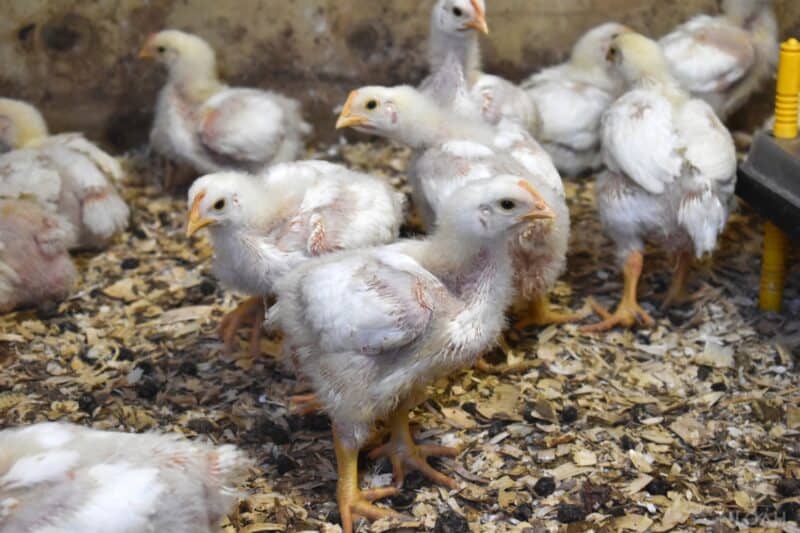
But, it can take a long time to raise a conventional breed, like a Rhode Island Red or even a Freedom Ranger, to a big enough size to butcher.
Enter – the Cornish Cross chicken. These birds are specially bred to produce lots of tender, flavorful meat in as little time as possible (as little as six weeks, in fact).
So is raising Cornish Cross chickens right for you – and most importantly, what else is there to know about this unique breed? Keep reading to learn more in this full guide on Cornish Crosses…
What Are Cornish Cross Chickens?
Cornish Cross chickens are the result of breeding a Cornish chicken with a White Rock chicken.
The Cornish chicken is known for its muscular build and tender meat, while the White Rock chicken is famous for its efficient feed conversion and egg-laying abilities.
By crossing the two, farmers were able to produce a chicken that had the best of both worlds – a bird that grew quickly and had high-quality meat (but sorry – no luck on the egg front. More on this aspect later).
Cornish Cross chickens are easy to spot because of their white feathers and yellow skin, a result of their Cornish genetics. They have a broad, muscular chest and legs, and can grow quite large – up to eight pounds for roosters and six for hens.
What’s So Special About Them?
Again, Cornish Cross chickens are known for their rapid growth, reaching market weight in just six to ten weeks. This makes them ideal for homesteaders who want to raise chickens for meat quickly and effectively.
Early on in my family’s farming journey, we raised Rhode Island Reds for meat on our farm. We loved that Rhode Island Reds are dual-purpose birds, providing us with both eggs and meat, but hated how long it took for them to be ready for the dinner table.
Because you have to wait so long for these birds, along with other types of heritage chicken breeds, to be ready for slaughter, the meat is often tough and not very flavorful. It’s great for the stew pot, but if you want a nice, juicy chicken breast, Cornish Cross chickens are the way to go.
Not only that, but they don’t get as large, and it costs a lot more to feed them – you’re growing them out longer, so the inputs are higher. Simple math!
After a few years of raising Rhode Islands, we switched to Cornish Crosses and haven’t looked back.
Despite their size and rapid growth, Cornish Cross chickens are actually quite easy to raise. In my experience, they don’t require a lot of space or special care, and they are very docile and friendly.
When raised properly, they are also hardy and can tolerate a range of temperatures and conditions (provided that it doesn’t get too hot.
Living in the Northeast US, we don’t have a problem with heat most summers, but it’s important to note that they don’t do well in extreme heat)…
Are Cornish Cross Chickens Good Egg Layers?
Cornish Cross chickens are not known for their egg-laying abilities. There are a few reasons why.
Let’s start by mentioning that Cornish Cross hens could technically lay eggs, if allowed to get old enough. Like any other breed, hens would begin to lay eggs at around 20 weeks of age.
That said, Cornish Cross chickens are specifically bred to grow very quickly, to a very large size. Letting them to live past the recommended eight or ten weeks is risky…
They’re likely to develop leg issues (including legs that spontaneously snap and break under the pressure of their heavy bodies) and heart problems.
In fact, a few years ago, I had a friend who allowed her Cornish Cross chickens to live past the recommended ten weeks because of time constraints related to butchering.
We visited them when the chickens were around sixteen weeks old, and things weren’t going well. Most of the birds had died of heart attacks, and the ones that were still alive were barely hobbling around.
From an animal welfare standpoint, I really don’t recommend allowing Cornish Crosses to live to egg-laying age.
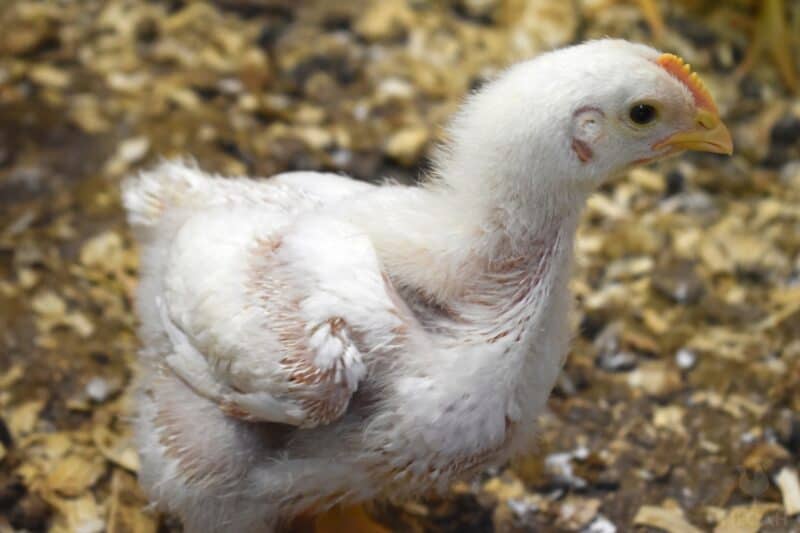
Common Problems With Them
While it’s true that Cornish Crosses grow quickly, there are also some issues you might run into before they get there…
1. Respiratory Problems
Respiratory issues may be the result of poor ventilation, dusty bedding, or bacterial infections. While this can happen with just about any breed of chicken, it’s more common in Cornish Crosses – there’s a lot of stress being placed on those tiny lungs by their massive bodies.
Symptoms of respiratory problems include wheezing, coughing, and runny noses. To prevent them, make sure your chicken coop is properly ventilated, clean the bedding regularly, and keep your chickens’ feed and water clean.
Or, better yet, do what we do and raise your birds in a chicken tractor once they’re old enough to be outside. This will eliminate respiratory issues altogether.
2. Leg Problems
As expected, leg issues may arise due to their rapid growth, which puts a lot of strain on their legs and joints. You’ll notice things like lameness, difficulty standing and walking, and swollen joints.
Occasionally, these problems can cause a Cornish Cross to become completely lame. We’ve almost always found that in this case, the bird will need to be culled early.
To prevent these problems, make sure your chicken’s diet is well-balanced with the right amount of protein, calcium, and vitamins.
Also, providing your birds with ample space to move around will help them stretch those legs – again, chicken tractors can help, and I’ll give you more info on that in a bit.
3. Heart Attacks
You probably didn’t want to hear this, but yes, Cornish Cross chickens are also prone to heart attacks.
We’ve had this happen a few times as well, but have gotten pretty good at timing our slaughtering now so that it rarely ever happens.
Nevertheless, to avoid heart issues, it’s vital to keep your chickens on a consistent feeding schedule with a balanced diet, plenty of water, and enough room to move around. The same things we humans should do, too!
4. Heat Stress
This breed of chickens is sensitive to high temperatures, which can cause heatstroke, dehydration, and even death in severe cases.
Keep your coop well-ventilated with proper shade,. Give them cool water, and feed them during the cooler parts of the day. Some frozen treats could work, too.
If you live in a cooler climate, as I do, you can probably get away with raising your meat birds in the summer.
However, I’ve heard from folks in warmer climates that they prefer to raise their Cornish Crosses in the spring, fall, or even winter to avoid heat stress altogether.
Tips on Caring for Cornish Cross Chickens
Feed the Right Food
Cornish Crosses are known for their rapid growth, and selecting the right feed for them is critical for their overall health and to make sure they gain weight at a reasonable pace.
For the first four weeks, I recommend you feed them a 23% protein starter.
Afterward, switch to a 20% protein grocer for the remainder of the time. With their rapid growth patterns, these birds may feel the stress of quick weight gain, so you need to be mindful of this.
It’s also a good idea to add a vitamin stress pack to your feeding routine to reduce stress on your birds.
Think About the Time of the Year
The time of the year is, again, also a crucial factor to consider when caring for these sensible chickens.
During the summer, these birds may struggle in the heat, as we’ve just talked about, so always be mindful of the climate and how the weather outside changes from week to week.
Consider Raising Them in Chicken Tractors…
A chicken tractor is a movable coop that allows chickens to forage and graze on fresh grass, which can be highly beneficial to their health.
Raising Cornish Crosses in chicken tractors helps provide them with enough space and fresh air to run, scratch, and find insects. Moreover, it enables them to have access to fresh grass and insects that will supplement their diet.
The biggest benefit we’ve found in raising these birds in chicken tractors is that it dramatically improves their lifespan and reduces health issues.
We rarely have birds succumb to issues like leg problems or heart attacks because they have enough room to move around. Incidences of aggression among the birds are few and far between, too.
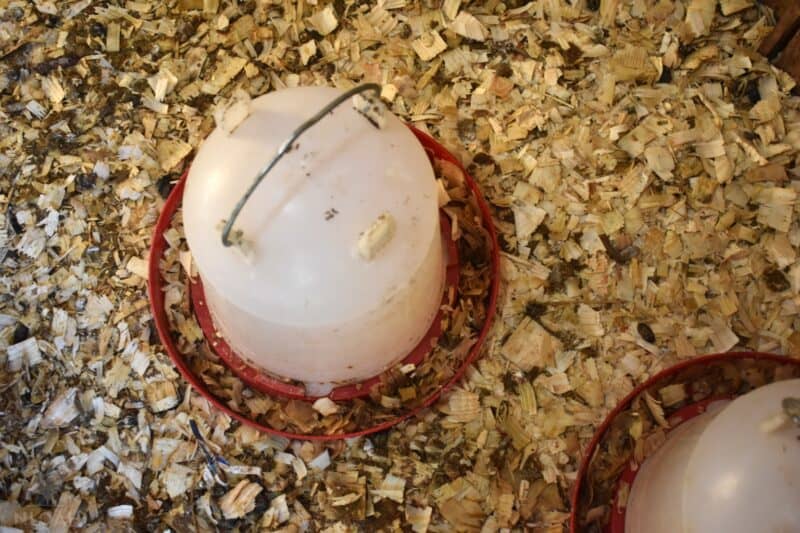
…Or Plan to Clean the Coop Often
If you do decide to keep your chickens in a stationary coop, plan to clean it regularly. The rapid accumulation of chicken droppings can lead to the growth of bacteria and cause the respiratory problems I mentioned above.
In the picture above, you’ll see how dirty the coop floor is after just one day. There are not that many birds in this brooder barn – maybe 40 – and this picture was taken just a day after cleaning.
Fortunately, we don’t keep our chicks indoors for that long (they’ll be going outside for three weeks), but you can see why it’s so important to clean often.
Have a Plan for Butchering
Remember, these birds grow quick – so I recommend having a tentative butcher date penciled in your calendar before your chicks even arrive on your homestead.
Shoot for eight weeks, and you can always add a few more weeks if you want your birds to get a bit bigger.
If you’re having someone else process them for you, book a date far ahead of time to make sure you can get them in before they start to succumb to weight-related health problems.
Breeding and Brooding Cornish Cross Chickens
I don’t recommend trying to breed Cornish Cross chickens yourself. The chicks won’t hatch true to the parents, since these are hybrid birds, and you’re probably going to be disappointed.
Instead, buy your baby chicks from a reputable hatchery, either by doing a mail order or by checking with your local farm supply store.
Look for breeders who have been in the business for a long time and have a proven track record of producing healthy, robust chicks.
Once they arrive, usually at a day old, be quick to provide them with a safe and comfortable brooder. It should have a heat lamp, water source, feeder, and clean bedding.
Cornish Cross chicks are notorious for eating and drinking a lot, so make sure you give them with enough food and water. Feed them a starter feed that contains at least 20% protein, and make sure that the feeder is always full.
I’ve heard some people recommend not keeping the feeder full at all times, as this can lead to overeating. I’ve experimented with it both ways, and found that by not keeping the food supply topped off all the time, it led to the death of a lot of chicks.
My theory is that the larger chicks will bully the smaller ones away from the feeder at prime feeding time, and the smaller ones will eventually die because they don’t get enough to eat.
You can try it either way, but I recommend keeping the food topped off at all times.
Remember, you’ll need a heat source. We use heat plates to provide consistent, even heat to our chicks…
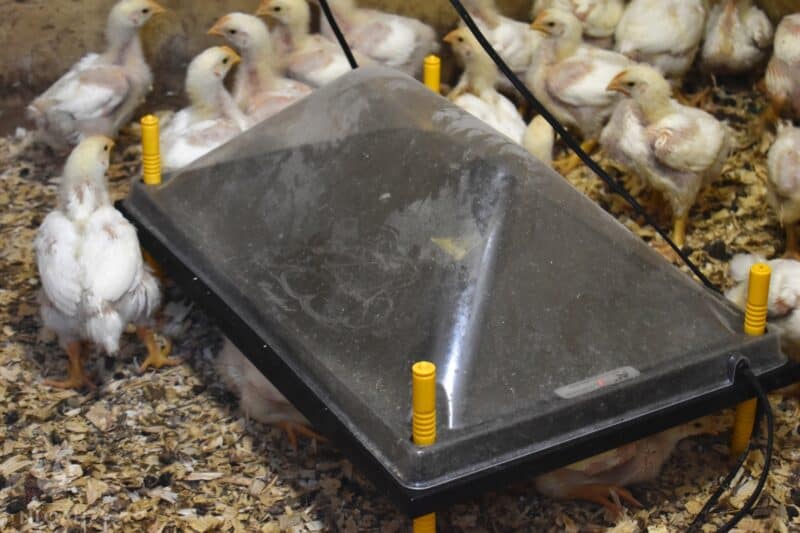
When your chicks are old enough, you need to move them to a larger coop or chicken tractor. We usually move ours at around three weeks, depending on the weather and how feathered out the birds are.
Cornish Cross chickens may grow faster than most breeds, but they still need ample space to move around and exercise.
A general rule of thumb is to provide at least two square feet of floor space per bird. If you’re raising them in confinement, make sure the coop is well-ventilated and has enough light.
Lifespan
Generally, Cornish Crosses typically live around 5 to 9 weeks, or up to 12 weeks if you feed them a low-protein diet. This breed’s sole purpose is meat production, so their genetics are engineered for rapid growth and fast maturity. Again, I recommend butchering your chickens when they are no older than 10 weeks.
Monitor their weight and use your best judgment. Sometimes, you may be able to stretch out your time to slaughter a bit longer, to 12 weeks or so, as I mentioned, but most of the time, they’re going to be at a good weight at 10, and you aren’t going to gain much by keeping them any longer.
Remember, these birds are specifically bred to reach market size in a short amount of time, resulting in a shorter lifespan. Once they reach the desired weight, they need to be processed for meat.
Are There Any Alternatives to Cornish Cross Chickens?
Indeed there are… The Freedom Ranger is a popular alternative. These birds have a slower growth rate, taking 10-14 weeks to reach processing weight. While they have smaller breasts than the Cornish Cross, they have more dark meat.
The Freedom Ranger is known for being a very active bird, which can be good for homesteaders who want more self-sufficient chickens that can forage and search for their own food. They’re also a hardy bird breed that can do well in a variety of climates.
Another option for homesteaders is to choose a dual-purpose breed that can be used for both meat and egg production. Some examples of dual-purpose breeds include the Rhode Island Red, Plymouth Rock, and Sussex.
While these breeds may not grow as quickly or produce as much meat as the Cornish Cross, they are good sources for both meat and egg production. They also allow for more self-sufficiency since you can hatch your own eggs.
All that said, I do prefer Cornish Cross chickens for meat on my own farm. They grow quickly, and to a decent size, so it’s easy to get large quantities of meat with minimal inputs. We get our chicken production done and over with, so we can get on with the rest of our summer!
These birds might not be the best choice for everyone, but for us – and for many homesteaders – they just make the most sense. Give them a try, and you’re sure to be amazed!
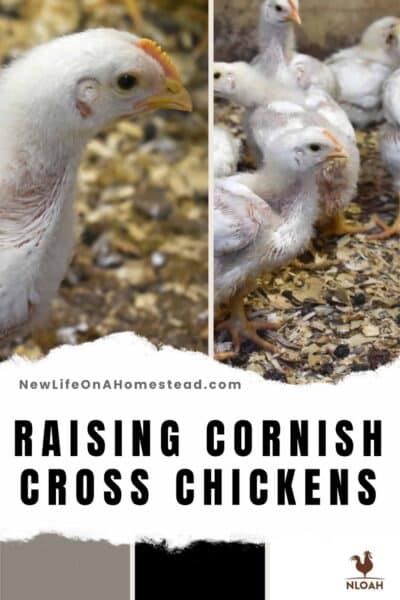
Tom has lived and worked on farms and homesteads from the Carolinas to Kentucky and beyond. He is passionate about helping people prepare for tough times by embracing lifestyles of self-sufficiency.
